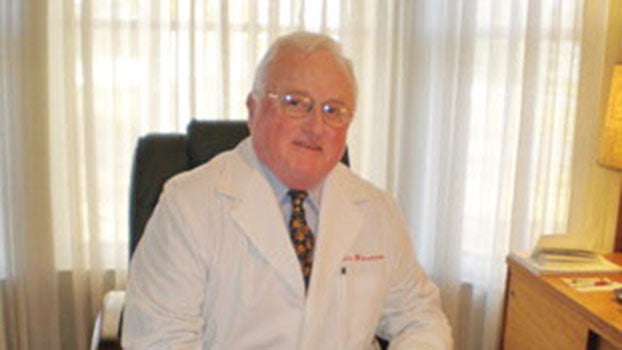COLUMN: We should approach the use of cannabis with caution
Published 11:20 am Saturday, February 17, 2024

- Wierman
|
Getting your Trinity Audio player ready...
|
By Dr. James L. Wierman, D.O.
With the legalization of marijuana in Michigan, in Cass County – along with communities across the state – cannabis products have become widely available to people who use them for both recreational and “medical” purposes. As a physician of long-standing in Cass County, I want to urge some caution and correct some misperceptions about plant-based medicine and the medical value of cannabis.
Assertions have been made that the medical community – including the American Medical Association, various drug companies and government agencies such as the Food and Drug Administration – has a conspiracy against cannabis and other plant-based products for use as medicine. However, the FDA did approve Marinal, synthetic THC, back in the mid 1980s, hoping that it would help nausea produced by chemotherapy and for the wasting process in HIV/AIDS. Also, as one example from the local medical community, my daughter is an infectious disease specialist and treats HIV patients. She has been using Marinal for years for a few of her HIV patients. She says, “it may help a little, but it is not impressive.”
Medicine does use natural products. For example, salicylates – aspirin – were derived from the willow tree bark. The Sumerians were noted to have used remedies derived from the willow tree bark for pain management as far back as 4,000 years ago. Hippocrates used it for the management of pain and fever. The Fox Glove plant that produced digitalis dates to the 17th century, and cocaine from cocoa beans for local anesthetics dates to the 1800’s. Cocaine nasal spray is the best for controlling nosebleeds because local anesthesia affects vasoconstriction. Morphine was isolated from the poppy plant in the early 1800’s and was used extensively in the Civil War. Bark from the Cinchona tree in South American produced Quinine which was used for Malaria in the 19th century, allowing for exploration of Africa in about 1870.
According to information published in April 2023 in the Pew Research Center, 46 percent of U.S. adults have used marijuana sometime in their life, 19 percent in the last year and 13 percent in the last month. According to the National Institute on Drug Abuse, 5.8 percent of the U.S. population over the age of 12 have Cannabis Use Disorder, which is defined as out-of-control use of this drug, with the drug dominating their lives. Risk factors for Cannabis Use Disorder are frequency of use, duration of use, and potency of the cannabis used.
Recent studies (uptodate.com) and my own experience have reported the following data and examples:
- Cannabis use causes transient acute psychosis in some users. I have admitted several patients with acute psychosis from smoking cannabis, some worse than others. I remember a patient brought to the ER by his mother because he was confused. She said that he had just been released from Jackson prison and was smoking a lot of pot. Drug tests were negative except Marijuana. I admitted him and a few hours later he hit a nurse and became very violent. We had to call everybody we could, including the local police to hold him down, while I gave him more major sedation. Finally, we had to put him to sleep with general anesthesia.
- A few years ago, I was called to the emergency room to admit an 8-year-old little girl that was hallucinating. She had taken some cannabis gummies that her older cousins had left at grandma’s house. She was admitted and had to be sedated for over 12 hours. Needless to say, her parents and grandma were very upset.
- MRI tests show an association between long term cannabis use and reduced gray matter density and thinning of the frontal cortex and cerebellum. In other words, cerebral atrophy.
- Cannabis use by mothers during pregnancy is associated with increased risk of premature birth, low birth weight, small for gestational age, neonatal care admission in most but not all studies. THC, and perhaps other cannabinoids appear in the breast milk of lactating women who use cannabis.
- Individuals with Cannabis Use Disorder are five times more likely to start using narcotics and other drugs like cocaine and methamphetamines.
- Some experts believe that early cannabis use is a factor in the development of schizophrenia.
- Cannabis use exacerbates symptoms in individuals with established psychotic disorders such as schizophrenia.
- Cannabis use by adults with PTSD is associated with more severe PTSD symptoms.
- ADHD is a risk factor for later development of Cannabis Use Disorder.
- Cannabis use acutely impairs cognitive functions including attention, concentration, episodic memory, and associative learning in a dose dependent fashion.
- Longitudinal studies have suggested an association with long term cognitive impairment.
- Systemic reviews and prospective longitudinal studies find consistent associations for cannabis use with lower educational attainment.
- Cannabis acutely impairs driving performance and increases accidents.
- Cannabinoid hyperemesis syndrome is a well-defined syndrome involving episodic severe nausea, vomiting and abdominal pain associated with heavy or chronic cannabis use.
Perhaps most readers know people who use cannabis for chronic pain, muscle spasms in MS, seizure, palliative, and terminal care, and who report some positive feedback. Currently, however, potential benefits are poorly studied.
One could easily write similar articles regarding the misuse of alcohol and nicotine products. My point is that any of these legal substances need to be used with caution. Just because a substance is considered “natural” is a meaningless argument and does not negate the numerous problems associated with the habitual use of cannabis.
Dr. James L. Wierman, D.O. specializes in internal medicine in Southwest Michigan and has more than 57 years of experience in the field of medicine. Wierman is a Diplomate of American Board of Internal Medicine and is an American College of Physicians Fellow.



